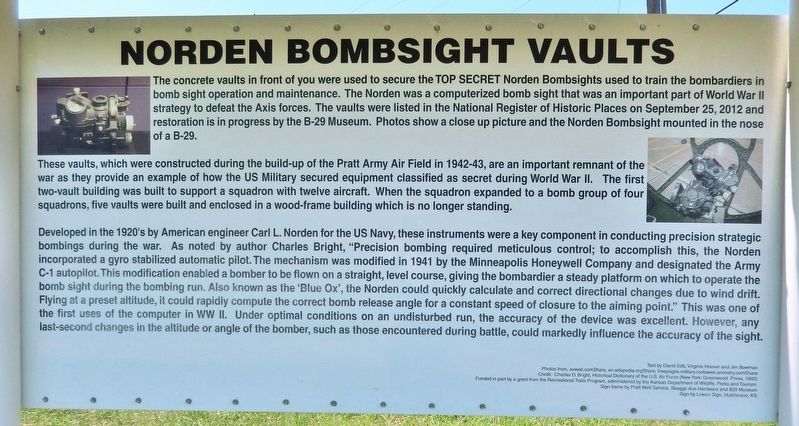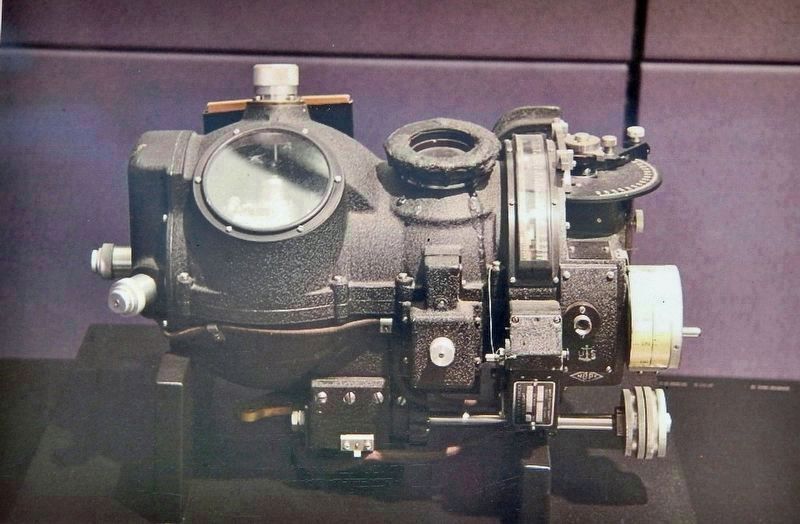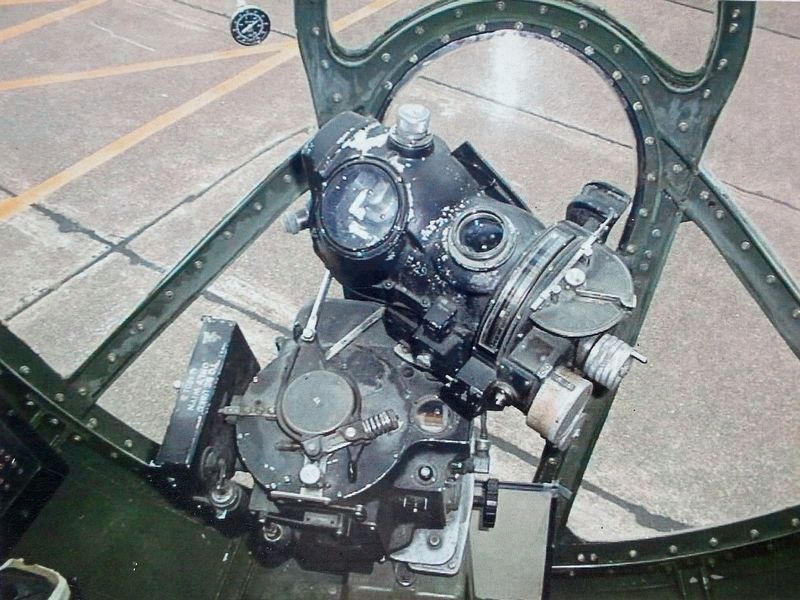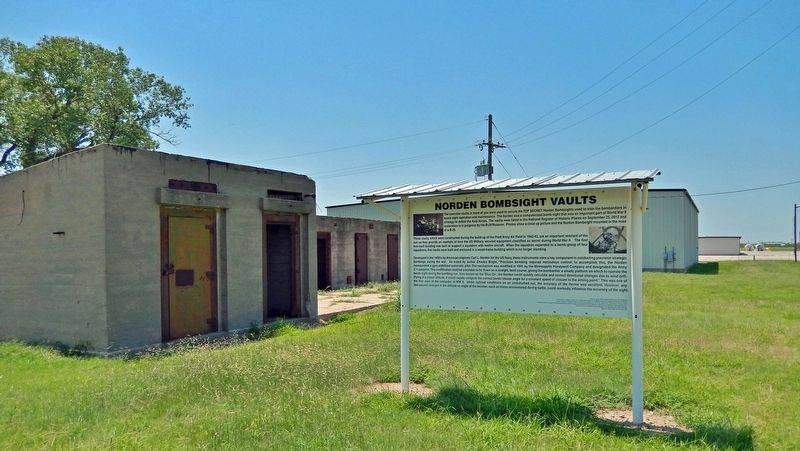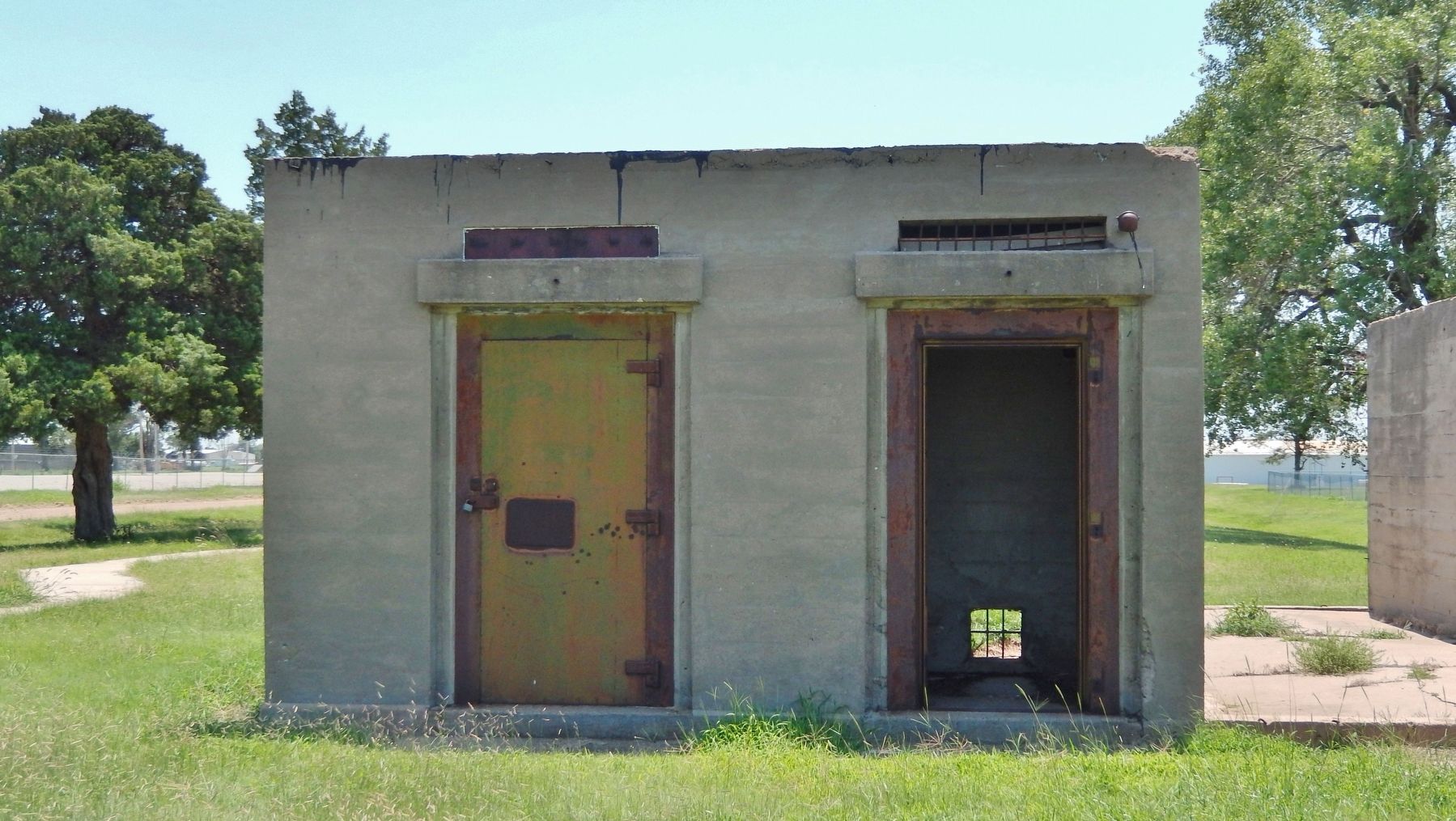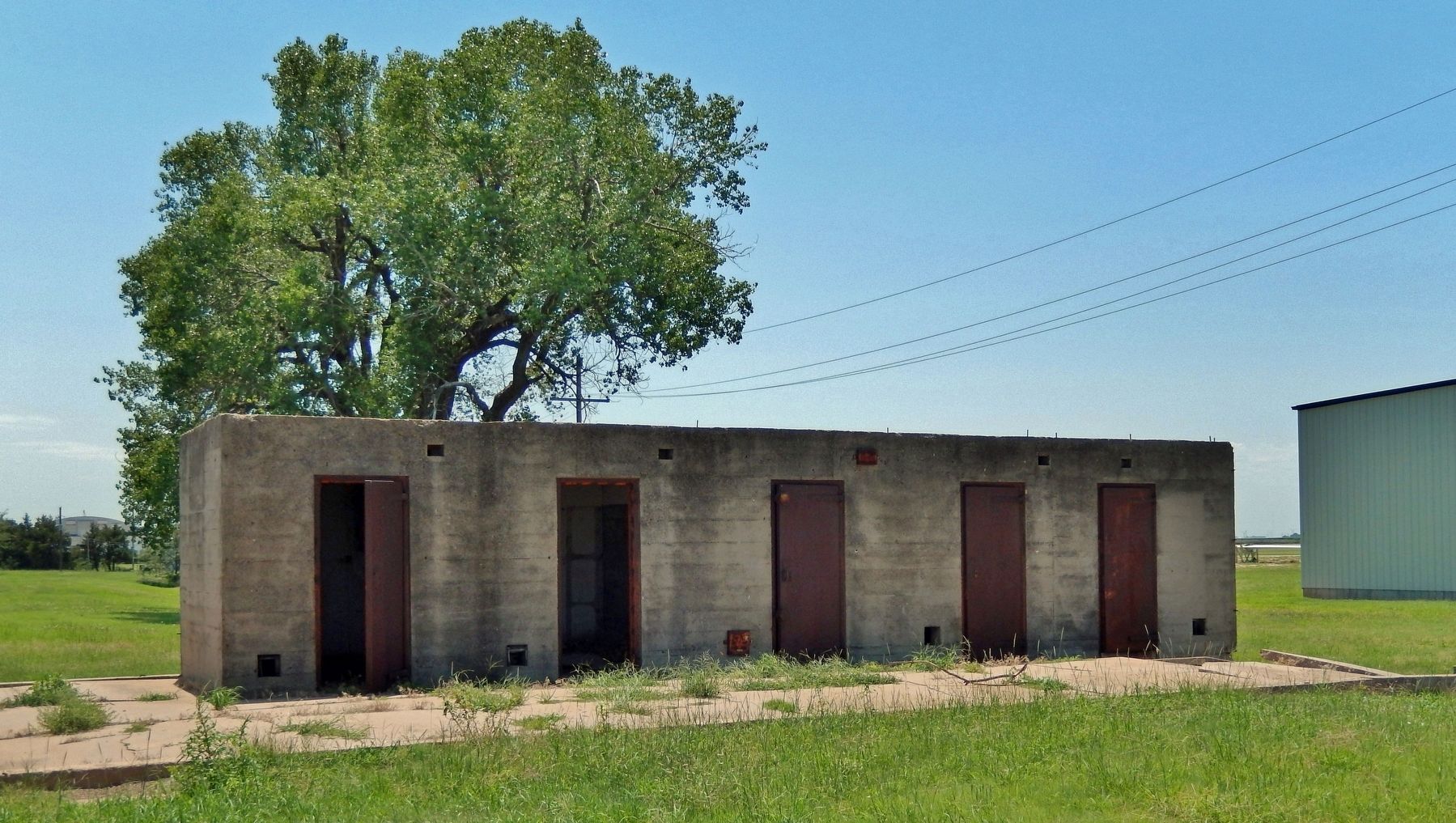Pratt in Pratt County, Kansas — The American Midwest (Upper Plains)
Norden Bombsight Vaults
The concrete vaults in front of you were used to secure the TOP SECRET Norden Bombsights used to train the bombardiers in bomb sight operation and maintenance. The Norden was a computerized bomb sight that was an important part of World War II strategy to defeat the Axis forces. The vaults were listed in the National Register of Historic Places on September 25, 2012 and restoration is in progress by the B-29 Museum. Photos show a close up picture and the Norden Bombsight mounted in the nose of a B-29.
These vaults, which were constructed during the build-up of the Pratt Army Air Field in 1942-43, are an important remnant of the war as they provide an example of how the US Military secured equipment classified as secret during World War II. The first two-vault building was built to support a squadron with twelve aircraft. When the squadron expanded to a bomb group of four squadrons, five vaults were built and enclosed in a wood-frame building which is no longer standing.
Developed in the 1920's by American engineer Carl L. Norden for the US Navy, these instruments were a key component in conducting precision strategic bombings during the war. As noted by author Charles Bright, "Precision bombing required meticulous control; to accomplish this, the Norden incorporated a gyro stabilized automatic pilot. The mechanism was modified in 1941 by the Minneapolis Honeywell Company and designated the Army C-1 autopilot. This modification enabled a bomber to be flown on a straight, level course, giving the bombardier a steady platform on which to operate the bomb sight during the bombing run. Also known as the 'Blue Ox', the Norden could quickly calculate and correct directional changes due to wind drift. Flying at a preset altitude, it could rapidly compute the correct bomb release angle for a constant speed of closure to the aiming point." This was one of the first uses of the computer in WW II. Under optimal conditions on an undisturbed run, the accuracy of the device was excellent. However, any last-second changes in the altitude or angle of the bomber, such as those encountered during battle, could markedly influence the accuracy of the sight.
Text by David Stitt, Virginia Hoover and Jim Bowman
Photos from, avweb.comShare, en.wikipedia.orgShare, freepages.rnilitary.rootsweb.anestry.comShare
Credit: Charles D. Bright, Historical Dictionary of the U.S. Air Force (New York Greenwood Press, 1992)
Funded in part by a grant from the Recreational Trails Program, administered by the Kansas Department of Wildlife, Parks and Tourism.
Sign frame by Pratt Well Service, Skaggs Ace Hardware and B29 Museum
Sign by Lowen Sign, Hutchinson, KS
Erected by
Kansas Department of Wildlife, Parks and Tourism; B-29 Museum; City of Pratt; and Airport Authority.
Topics and series. This historical marker is listed in these topic lists: Air & Space • Architecture • War, World II. In addition, it is included in the National Register of Historic Places series list. A significant historical year for this entry is 1942.
Location. 37° 42.237′ N, 98° 44.55′ W. Marker is in Pratt, Kansas, in Pratt County. Marker is on Flint Road just west of Kennedy Avenue, on the left when traveling west. Marker is about 2 blocks west of the B-29 All Veterans Memorial. Touch for map. Marker is at or near this postal address: 40131 Barker Avenue, Pratt KS 67124, United States of America. Touch for directions.
Other nearby markers. At least 8 other markers are within walking distance of this marker. The City of "PAAF-Ville" (here, next to this marker); Base Operations Building (a few steps from this marker); Aircraft Control Tower (a few steps from this marker); Celestial Navigation and Bombing Trainer (within shouting distance of this marker); Link Aviation Flight Simulation Trainer (within shouting distance of this marker); PAAF - Pratt Army Airfield (about 400 feet away, measured in a direct line); Pratt Army Air Field Historical Walk (about 400 feet away); Pratt Army Air Field and the B-29 "Superfortress" (about 500 feet away). Touch for a list and map of all markers in Pratt.
Regarding Norden Bombsight Vaults. National Register of Historic Places #12000816.
From the National Register Nomination:
World War II-Era Aviation-Related Facilities of Kansas
Architects: U.S. Army Corps of Engineers
Related markers. Click here for a list of markers that are related to this marker. Pratt Army Air Field Historical Walk
Also see . . .
1. Norden Bombsight Storage Vaults. Excerpt:
The Norden Bombsight Storage Vaults located at Pratt Army Airfield were built between 1942 and 1943 and provided a secure space to store, maintain, and issue the Norden Bombsights, which were classified as secret during most of World War II. Although the historic integrity of the surrounding airfield has diminished with the construction of modern warehouses to adapt to changing uses, these vaults are an important remnant of the broader air defense strategy during World War II.(Submitted on August 7, 2023, by Cosmos Mariner of Cape Canaveral, Florida.)
2. Norden Bombsight. Excerpt:
It was an early tachometric design that directly measured the aircraft's ground speed and direction, which older bombsights could only estimate with lengthy manual procedures. The Norden further improved on older designs by using an analog computer that continuously recalculated the bomb's impact point based on changing flight conditions, and an autopilot that reacted quickly and accurately to changes in the wind or other effects. The Norden saw reduced use in the post–World War II period after radar-based targeting was introduced, but the need for accurate daytime attacks kept it in service, especially during the Korean War. The last combat use of the Norden was in the U.S. Navy's VO-67 squadron, which used it to drop sensors onto the Ho Chi Minh Trail in 1967.(Submitted on August 7, 2023, by Cosmos Mariner of Cape Canaveral, Florida.)
Credits. This page was last revised on August 8, 2023. It was originally submitted on August 6, 2023, by Cosmos Mariner of Cape Canaveral, Florida. This page has been viewed 114 times since then and 44 times this year. Photos: 1, 2, 3, 4, 5, 6. submitted on August 7, 2023, by Cosmos Mariner of Cape Canaveral, Florida.
